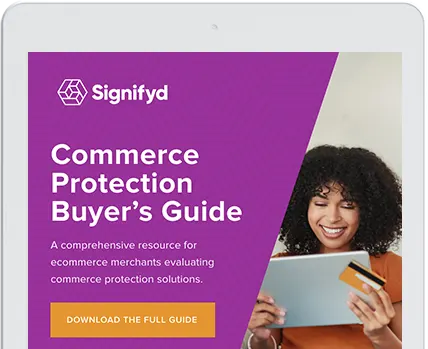As ecommerce continues its digital transformation, it is more important than ever that you have control over how machine-learning solutions affect your business.
After all, automating chargeback fraud protection can make a significant impact on both your top-line revenue and your customers’ experiences. You not only need transparency into what your commerce protection solution is doing to identify fraudsters, you need to be able to modulate your responses to threats according to the specific market realities you face.
Even end-to-end automation needs human-in-the-loop capabilities
Unfortunately, the nature of most AI-based commerce protection solutions is that the technology operates in a “black box,” sight unseen. You know the inputs, and you see the outputs, but you are hands-off while the AI engine works. There’s a semi-valid reason for setting up a solution that way: some solutions boast that they can process orders automatically without disrupting your workflow or interrupting the purchase journey of the shopper.
But to maintain vendor accountability, it is imperative for commerce protection solutions to include not just transparency into the network and decision engine (which we discussed in the previous blog and in our Commerce Protection Buyer’s Guide), but control mechanisms that give you the final say over how you protect your business. This precludes using black-box AI for your ecommerce fraud protection in favor of transparency into the inner workings of the AI engine.
Second in a series
This is the second in a blog series inspired by Signifyd’s Commerce Protection Buyer’s Guide. The series explores the questions that retailers and brands should ask and the factors they should consider when searching for a future-focused commerce protection platform. The series on the Signifyd blog will explore the roles of:
- Transparency
- Control
- Performance
- Time to value
We hope you find this work valuable. Feel free to reach out with your thoughts and suggestions.
For the right kind of control, your commerce protection solution should offer two key features: A transaction-level console and a business-policy control center.
- Transaction-level console: This allows you to search and review orders processed by your commerce protection provider. In addition to giving you search capabilities that provide insight into a rich assortment of data and processes, for control reasons, your solution should also provide you with the ability to add and track specific orders and to update orders with new information such as a change of address or new contact information.
- Business policy control center: Your solution should also have a self-service interface that allows you to create, test, enforce and monitor unique business policies that mitigate consumer abuse and reward loyal customers.
This interface would give you the capability to implement policies at various checkpoints across the shopper’s journey, such as account creation, login, card add, checkout, pre-authorization and refund/return request.
Your commerce protection solution should also have modules that identify specific abuse use cases such as promo abuse, reseller abuse, and return abuse, as well as give you the ability to test and simulate policies before going live to mitigate impacts on the customer experience.
How machine learning models work
Machine learning models sit atop a commerce protection provider’s cross-merchant network and unite network insights with information specific to an incoming order. This way, the model can identify patterns that either confirm that the order is legitimate or flag an attempt at fraud. These machine-learning models have three goals:
- Deliver decisions in real-time for an optimal checkout experience for the shopper
- Offset and optimize the “rules” that help the system identify patterns so as to constantly improve the model’s ability to spot evolving fraud and abuse trends
- Avoid false declines and fulfill the maximum number of orders
To build these models, the commerce protection vendor’s data scientists use a technique called “feature engineering.”
How feature engineering works
Features are independent variables used by machine learning models that—when taken in aggregate—make predictions. Commerce protection models leverage variables such as identity features, behavioral features, history and network features, and device features – employing methods such as aggregation, linking and velocity analysis – to recognize legitimate orders and block fraud.
- Identity features. This variable links personally identifiable information (PII) data such as email, phone, billing and shipping addresses, and payment cards to one persona.
- Behavioral features. This variable spots patterns derived from analysis of behavioral and velocity data.
- History and network features. These aggregate both merchant-specific and network-wide order histories to establish recognizable purchasing patterns.
- Device features. This feature recognizes devices by linking device fingerprinting data with geolocation intelligence and previous device history.
How to evaluate a solution for control capabilities
When choosing a commerce protection solution, you should be asking the following questions:
- Can we resubmit transactions for review if there is additional information provided such as a shipping address change?
- How does your platform allow us to control the customer experience and support our business needs?
- How will our business policies interact with your platform’s fraud evaluation?
- Can you provide examples of the extent of your platform’s self-service capabilities?
- Can we deploy our own business and non-fraud fulfillment rules within your platform?
Make sure you are in control
Although end-to-end automation is a goal of commerce protection, it shouldn’t leave you with little say over how you protect your business. The last thing you want is to be completely unaware of how your solution is coming to its conclusions and predictions. Visibility into the process — and control over key aspects of it, should you choose to exert it—are critical. Choose a solution that gives you both.
Photo by Getty Images
Looking for commerce protection that offers you control? Let’s talk.








